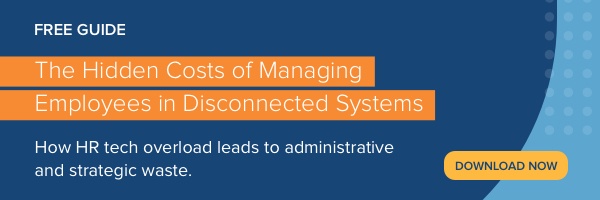How and where you store HR data is more important than you might think. It impacts the efficiency of your HR function and the effectiveness of your employee management activities.
Paper and Excel files waste time and limit your reporting capability, but when you store HR data for easy access and analysis, you gain greater visibility of your workforce and tools for better decision-making.
The Importance of Proper HR Data Storage
Having great data is one thing, but having HR data you can use is another. If you don’t have an effective method for storing HR data, you can miss out on valuable opportunities to leverage your HR data for powerful analysis and insights. A CEB (now Gartner) poll of HR leaders found that only 5 percent said their organization was effectively tracking and using talent analytics.
When you have the tools and technology to store HR data effectively, you spend less time looking for information and more time supporting your employees. Using an effective data storage method also delivers the following benefits:
- Helps satisfy legal requirements: Storing HR data in an organized way helps you stay in compliance with Equal Employment Opportunity Commission (EEOC) and Department of Labor rules for storing employment documents. It also helps you meet requirements for retaining employee data.
- Protects employee privacy and security: Secure data storage maintains employee privacy and protects sensitive employee data such as pay, dates of birth, and social security numbers.
- Improves reporting capability: You can make the most of your HR data when you have reporting tools to help you analyze trends and make better workforce management decisions.
Which HR Data Should You Store?
Organizing and storing HR data will come easier when you have a complete understanding of all the information and documents you need to track. Be sure to select a solution that can store HR data across the following categories:
Hiring and Onboarding
- I-9 employment verification documents
- Candidate resumes and applicant tracking data
- Offer letters and employment contracts
- Background check reports
- Onboarding documents
Payroll
- Employee W-4s
- Payroll records and employee W-2s
- Payroll deductions
- Employee salary and overtime rates
- Effective dates for bonuses and other payments
Schedules and Leaves
- Employee work hours
- Overtime reports
- Attendance records
- Paid and unpaid leaves
Benefits
- Employee elections and deductions
- Benefit plan summaries
Health and Safety
- OSHA reports
- Drug testing results
- Workers’ compensation claims
Performance Management
- Performance reviews
- Productivity reports
- Performance improvement plans
Training Records
- Certification records and dates
- Training attendance
Separation
- Resignation letters
- Severance agreements
- COBRA documentation
- Exit interview notes
The Top 5 Methods of Storing HR Data
Each stage of the employee lifecycle journey generates a sizable amount of data. You need a storage solution that can handle it all, while also meeting your needs for reporting and employee access. Here are five different methods of storing HR data:
1. Paper Records
Paper is tangible and easy to use, but it can be easily lost and requires a lot of storage space. Plus, creating a report or analyzing data trends is near impossible when you’re trying to do it from stacks of paper.
If you need to store some HR data in paper form, be sure to take the following precautions:
- Keep employee information in a secure location.
- Have backups of important information in case of fire or other damage.
- Invest in a filing system that makes it easy to find information quickly.
2. Manual Electronic Files
For a while, using Word documents and Excel spreadsheets was one of the only ways to organize employee data electronically. Electronic files are relatively easy to create and use, but they have some drawbacks, including:
- Multiple files can overload your desktop.
- Larger files are harder to share among team members.
- Tracking multiple file versions is cumbersome.
Manual electronic files may be appropriate when working with smaller data sets, and only a few people require access. Take the following steps to make the most of manual electronic files:
- Use templates to simplify document creation.
- Add password protection to documents containing sensitive employee information.
- Establish a process for tracking file updates.
3. Shareable Files
With the introduction of tools like Dropbox and Google Docs, it’s easier to share and update HR data. However, using these tools requires you to make updates and edits manually, which means you can still experience a lack of consistency between files and reports.
Shareable data files encourage collaboration more than paper or manual electronic files. To safely use shareable files for data storage, you will need to limit access to authorized users. You’ll also need a protocol for version control so you can keep track of who is making updates to the data.
4. Internal Company System
A proprietary HR data platform is tailored to your individual needs, but if your IT team can’t keep it maintained and up to date, you can end up with a system that doesn’t evolve with your workforce or the needs of your team.
If you’re using an internal company system, consider your ongoing needs for maintenance and upgrades. And, because internal systems can be costly, determine if there are alternative HR data management tools that can deliver a stronger ROI.
5. Cloud-Based Human Capital Management (HCM) Solution
A cloud-based HCM system provides HR data security and the ability to keep data consistently updated across all areas of employee management. Instead of managing payroll, benefits, and other HR services with separate systems, you can do it all with one integrated platform.
An all-in-one HCM solution allows you to take a top-line view of your workforce, while also drilling down into specific areas so you can run reports in areas such as recruiting, performance management, and training. Keeping your HR data in the cloud also provides access to members of your HR team, as well as others you designate. For example, employee self-service provides employees with access to their payroll information, along with important documents and forms.
Select a Comprehensive HR Data Management Solution
There are many methods of storing HR data, but not all can provide you with the accurate and up-to-date information you need for effective workforce management. When you use a cloud-based, all-in-one HR system, you not only keep your HR data accurate and secure, but you can track important metrics and enhance the employee experience with self-service. For more ideas to help you select the most comprehensive HR data management solution, read our e-book, The Hidden Costs of Managing Employees in Disconnected Systems.

